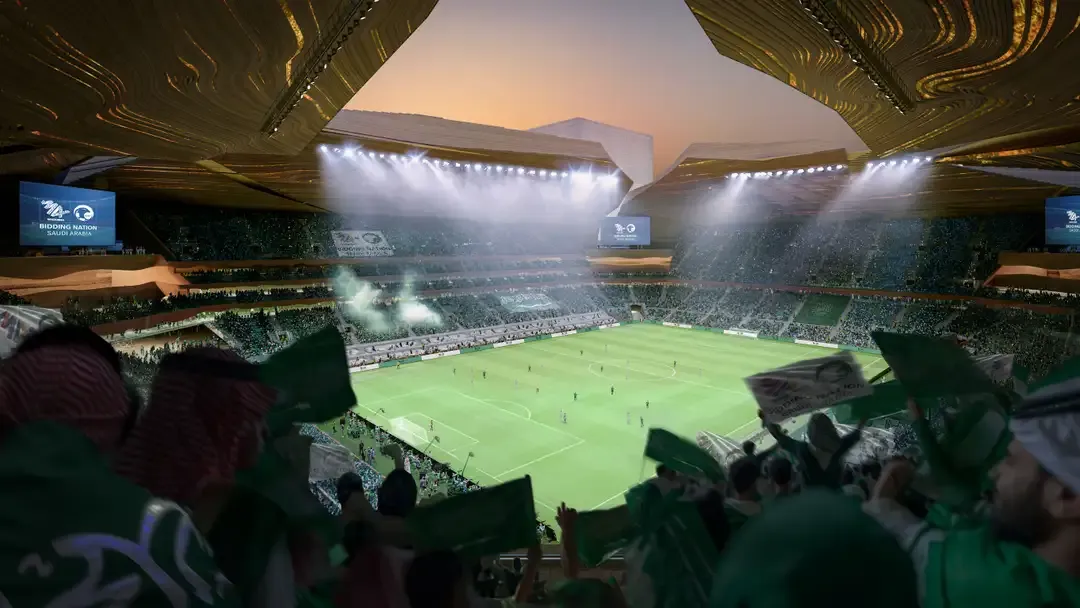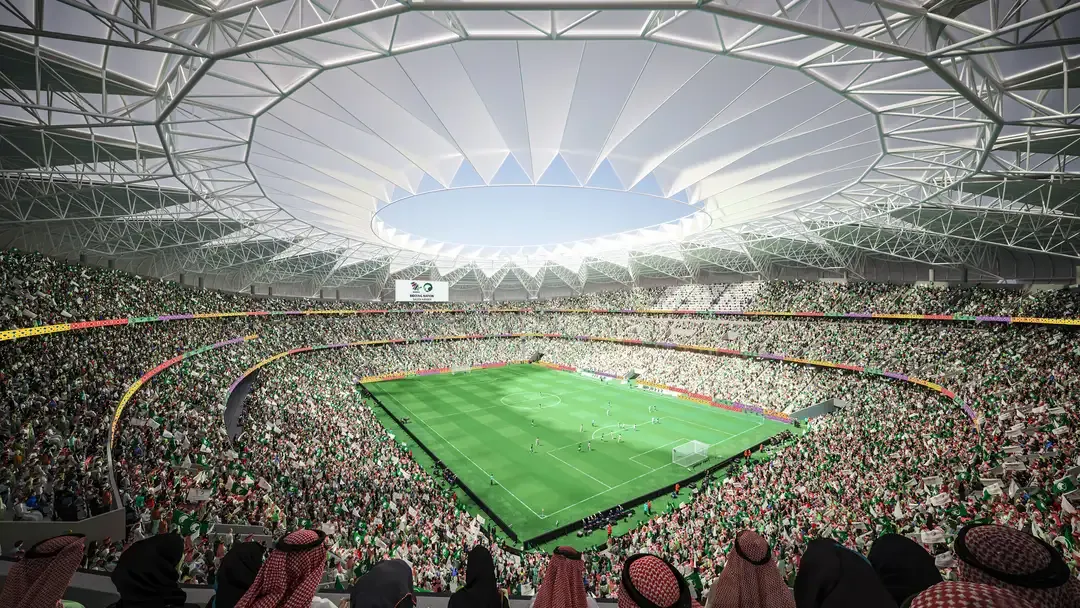15 Stadiums for the Saudi Arabia 2034 World Cup
)
We take a look at the 15 stadiums set to be ready for the 2034 world cup, each showcasing cutting-edge design and innovative landscaping that reflect the country’s rich cultural heritage and forward-thinking vision.
With a deep commitment to sustainability, many of these stadiums will incorporate renewable energy, locally sourced materials, and advanced green technologies. The new stadiums are not just venues for football—they will become landmarks in Saudi Arabia’s urban landscape, transforming the country’s cities into hubs of innovation, culture, and sport.
New Murabba Stadium (Riyadh)
Slated for completion in 2032, the New Murabba Stadium draws its inspiration from the bark of the native acacia tree, with its design featuring layered, textured forms that reflect the tree's unique appearance.
This 46,000-seat stadium will play a significant role in the tournament, hosting matches throughout the group stage and the Round of 16. Its integration into the Murabba downtown development makes it a landmark addition to Riyadh's urban landscape.

King Salman International Stadium (Riyadh)
The King Salman International Stadium, set to be completed by 2029, will become Saudi Arabia's largest stadium with a seating capacity exceeding 92,000. It is planned to host the opening match, the FIFA World Cup Final, and games across all rounds of the tournament.
As part of the Green Riyadh development masterplan, the stadium will be built with a strong focus on sustainability. Its design incorporates eco-friendly features and aims to seamlessly blend with the surrounding natural landscape, ensuring it serves as both a sporting and environmental landmark.
Designed as a crystalline structure with shards rising into the air, this stadium will feature a glowing lattice facade within a central urban plaza.

King Fahd Sports City Stadium (Riyadh)
Set for completion in 2026, the King Fahd Sports City Stadium will accommodate over 70,000 fans. Its striking design takes inspiration from the traditional tents of Saudi Arabia, creating a distinctive and culturally resonant aesthetic.
The stadium will serve as a key venue during the tournament, hosting matches across various stages and culminating in a prestigious semi-final in Riyadh.

Prince Mohammed bin Salman Stadium (Riyadh)
Scheduled for completion in 2029, the Prince Mohammed Bin Salman Stadium stands out as one of the most futuristic designs for the tournament. Featuring iridescent glass and shimmering metal, it exudes a sleek, cyberpunk-inspired aesthetic that sets it apart from traditional stadium designs.
With a seating capacity of nearly 50,000, the stadium will host matches during the group stages, the round of 32, the round of 16, and the third-place play-off, making it a centerpiece of the tournament's action.

Prince Faisal bin Fahd Sports City Stadium (Riyadh)
Set to be completed by 2027, the Prince Faisal Bin Fahad Sports City Stadium will accommodate over 46,000 spectators. It will serve as a key venue during the tournament, hosting matches in the group stages and the round of 32.
The stadium's construction emphasizes sustainability, utilizing locally sourced materials and incorporating green spaces around its perimeter. This design aligns with Saudi Arabia's commitment to an environmentally conscious World Cup.

South Riyadh Stadium (Riyadh)
Scheduled for completion by 2032, the South Riyadh Stadium will have a seating capacity of over 47,000. Its stunning design draws inspiration from the Wadi Hanifa seasonal river valley, paying tribute to this natural landmark that flows through the heart of Riyadh.
During the tournament, the stadium will host group-stage matches as well as fixtures in the round of 32, making it a significant venue for the competition.

King Saud University Stadium (Riyadh)
Currently an existing facility, the King Saud University Stadium is set to undergo significant expansion by 2032. Its capacity will increase from 26,100 to over 46,000, transforming it into a key venue for the tournament.
Once upgraded, the stadium will host matches during the group stages and the round of 32. Conveniently located adjacent to the U Walk, a vibrant mixed-use development, the venue will provide an enhanced experience for fans attending the games.

Neom Stadium (Neom)
The NEOM Stadium, set to become one of the most unique sports venues in the world, will feature a pitch situated more than 350 meters above the ground, offering breathtaking views and an unparalleled experience. Enwrapped by the futuristic infrastructure of the NEOM city, the stadium is designed to stand out as one of the world’s most iconic landmarks.
With a capacity of over 46,000 spectators, the NEOM Stadium will be fully powered by renewable energy, aligning with the city’s commitment to sustainability. It will host matches from the group stages through to the quarter-finals, marking its significance as a central venue for the tournament.

King Abdullah Sports City Stadium (Jeddah)
Opened in 2014 and nicknamed "The Shining Jewel," the King Abdullah Sports City Stadium boasts a capacity of 58,432. This iconic venue has already hosted numerous high-profile events, including WWE Premium Live Events, ATP tennis tournaments, boxing matches like Anthony Joshua vs. Oleksandr Usyk, and the 2023 FIFA Club World Cup Final.During the World Cup, the stadium will host group-stage matches and games through each knockout round up to the quarter-finals, further cementing its reputation as a premier sporting destination.

Qiddiya Coast Stadium (Jeddah)
Scheduled for completion by 2032, the Qiddiya Coast Stadium will have a capacity of over 46,000. Its design will evoke the iconic Mexican Wave, featuring a ripple effect and surrounded by lush green spaces, creating a dynamic and visually striking environment.
The stadium will host group-stage matches, as well as games in the round of 32 and the round of 16, making it an important venue in the tournament.

Jeddah Central Development Stadium (Jeddah)
Set for completion by 2027, the Jeddah Central Development Stadium will host matches during the group stage and the round of 32. Its design is inspired by the historic Al Balad district of Jeddah, which dates back to the seventh century and is recognized as a UNESCO World Heritage Site.
This connection to Jeddah's rich cultural heritage will provide the stadium with a unique architectural identity, blending tradition with modern innovation to create a landmark venue for the tournament.

King Abdullah Economic City Stadium (Jeddah)
Scheduled for completion in 2032, the King Abdullah Economic City Stadium will accommodate over 45,000 fans. It will host matches during the group stages and the round of 32.
The stadium's design draws inspiration from the natural beauty of local coral reefs found in the Red Sea and Gulf of Aqaba, reflecting the intricate growth patterns and vibrant colors of the reefs. This organic, oceanic aesthetic will make the stadium a stunning addition to Saudi Arabia's World Cup venues.

Aramco Stadium (Al Khobar)
Set to be completed by 2026, the Aramco Stadium is currently under construction and will be the only stadium in Al Khobar. With a seating capacity of over 46,000, it will host matches during the group stages, the round of 32, and the round of 16.
Inspired by the dynamic nature of the sea, the stadium's design celebrates the powerful influence of water on the local environment. Its fluid, wave-like architecture will create a striking visual identity, making it a standout venue for the tournament.

King Khalid University Stadium (Abha)
Currently an existing facility, the King Khalid University Stadium in Abha is undergoing refurbishments that are scheduled to be completed by 2032. The stadium’s capacity will be expanded from 22,000 to over 45,000, making it a significant venue for the World Cup.
Nestled in the mountains, the renovated stadium will offer modern amenities and advanced technology while retaining its unique mountainous setting. It will host matches during the group stages, the round of 32, and the round of 16.

Roshn Stadium (Riyadh)
Another standout with a futuristic flair, Roshn Stadium will showcase a glowing, crystalline exterior that makes it truly remarkable. Its design creates a dynamic and visually striking presence, particularly when illuminated at night.
With a capacity of 46,000, the stadium is scheduled for completion by 2032. During the tournament, it will host group-stage matches and at least one fixture from the round of 32.








